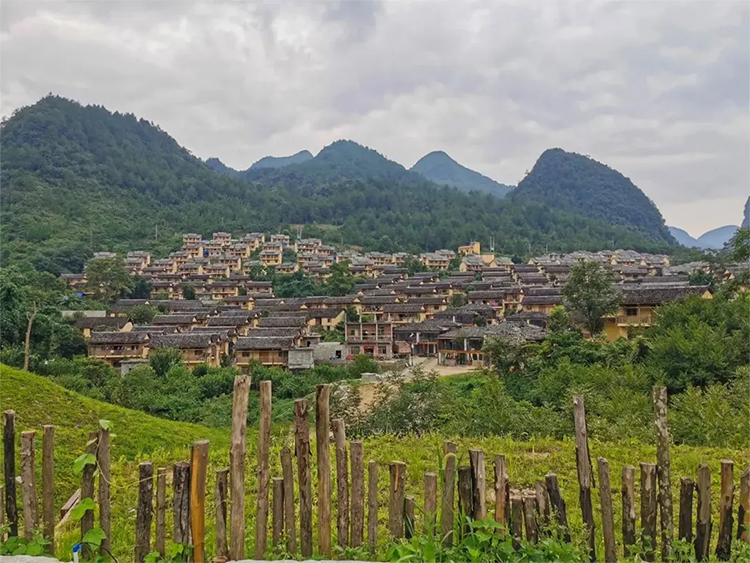Ethnic Village Tourism in Libo Yaoshan: Explore the Ancient Bai Ku Yao Village
Introduction
When morning light slices through Guizhou’s mist, rows of stilted wooden houses wake on the green slopes and the sound of bronze drums echoes through a karst valley. This is Libo Yaoshan Ancient Village, a time-capsule of the Bai Ku Yao people. For centuries they have preserved bronze-drum rites, indigo wax-resist dyeing, and competitive spinning-top games amid terraces and tower-like peaks. Step inside and you’ll encounter one of China’s most authentic ethnic-cultural experiences.
1. World-class living cultural museum
Yaoshan Ancient Village is more than a named historic settlement—it’s an open, living museum. Home to the Bai Ku Yao (White-Knee Yao) subgroup, the village’s name references the men’s distinctive white, knee-length shorts dyed with plant-based pigments, still everyday wear here. Ninety-eight stilted wooden houses cling to the hillside, each with animals sheltered on the ground floor, people living above, and grain stored on the top level—an architectural textbook for life in steep terrain.
Highlights:
– China’s most intact Bai Ku Yao traditional settlement
– A transmission site for UNESCO-recognized bronze-drum culture
– A breathtaking landscape where karst peaks and millennium-old rice terraces coexist
2. A Yao epic in a time tunnel
The village traces its roots to the Ming dynasty (Hongwu era), when Yao people fled conflict and carved out a new life on these rugged slopes. At the heart of the village sits the bronze-drum plaza: a bronze drum over one meter across and more than 600 years old. Its sun and frog motifs encode ancient nature-worship beliefs. Each lunar year on the 30th day of the sixth month, villagers don ceremonial dress and play twelve differently tuned drums in an ancestral rite whose scale rivals the grandest mythic festivals.
Unmissable cultural experiences:
– Spinning-Top Championship: watch masters spin 30-kg wooden tops on a blade’s edge
– Indigo Wax-Resist (Batik) Workshop: hand-draw Yao totems using fengxiang wax and natural dyes—an officially protected craft
– Long-Table Banquet: sample smoked meats, sour fish soup, and colorful glutinous rice on a century-long wooden table

3. Four-season living landscape
Libo, called a “green jewel on the planet’s belt,” cradles over 2,000 acres of terraces embraced by karst peaks. The scenery shifts like a giant oil painting with the seasons:
– Spring: flooded terraces mirror the mountains
– Midsummer: rolling green rice fields studded with indigo cloth drying racks
– Golden autumn: ripe rice, red maples, and stilt houses form a warm symphony
– Deep winter: seas of cloud sweep the terraces while chimney smoke and morning mist dance together
Best viewpoint: The Moon-Watching Terrace behind the village is ideal for terrace sunrises, sea-of-clouds, and Buddhist halo light. October–November harvest months are especially spectacular.
4. Immersive travel guide
Travel information
– By car: Drive from Guiyang via the Xiarong (Xiamen–Chengdu) Expressway to Libo county (about 3.5 hours), then follow County Road X918 for 40 minutes.
– Public transport: Six daily rural buses run from Libo Bus Station to the village (about 1 hour, ticket 15 RMB).
Practical details
– Entrance fee: 80 RMB (includes village and terrace viewing platform); student half-price
– Opening hours: 08:30–18:30 (extended to 19:30 in peak season)
– Guided tours: English guides available with 1-day advance booking (200 RMB per group)
Suggested itineraries
– Half-day highlights (3–4 hours): Bronze-Drum Plaza → Spinning-Top Workshop → Indigo workshop → Terrace walk
– Two-day deep dive:
Day 1: Make a Yao herbal sachet and stay overnight in a stilt house
Day 2: Join seasonal farm work and attend the live outdoor show “Yao Mountain Charm”

5. Practical tips for respectful travel
– Respect local customs: ask before photographing elders and do not touch the bronze drums
– What to wear: non-slip hiking shoes (stone paths can be slippery) and sun protection
– Beat the crowds: avoid National Day and Lunar New Year; bring rain gear for the June–August rainy season
Conclusion
In an era of commercialized heritage, Yaoshan Ancient Village still lives by the principle that people are the landscape. Sit by the hearth and hear an elder sing creation myths, or watch barefoot children chase tops on the village field—and you’ll understand that the true treasure here is not only the listed intangible heritage, but a way of life in harmony with mountain and water. Pack your bag and let the village smoke and songs wash the city dust from you.


